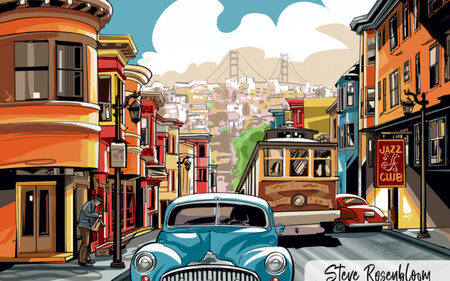
Montreal-based saxophonist and composer Steve Rosenbloom stakes his claim to the long lineage of the big band tradition with his latest album, “San Francisco 1948.” The vibrant, nine-track collection of originals is both affectionate towards its swing-era roots while also being unmistakably contemporary in its outlook.
The album is performed by a powerhouse ensemble of Montreal’s finest jazz musicians. The interplay between the brass, reeds, and rhythm sections has that finesse that only appears when seasoned musicians lock in under the guidance of a confident bandleader.
The album’s title points to a specific era and place, but this is not an indication of the repertoire of the record. Instead, it invokes the spirit of the moment with its bustling energy, cinematic sweep, and dance-floor propulsion.
https://open.spotify.com/embed/album/392Hg3VCNpRGTlxMh8OHdP
The opener, “Samba for Esther,” sets a buoyant tone with Latin-inflected rhythms that transport you to the streets of Brazil. An elegant piano solo kicks in during the interlude, stealing the spotlight from the horns without compromising on the overarching theme.
The mood shifts with “Call from the Orient,” a longer piece running for over 7 minutes. This track draws inspiration from pentatonic scales to create an atmosphere of mystery where modal harmonies and layered orchestrations create space for reflection.
https://music.apple.com/ca/artist/steve-rosenbloom-big-band/1816161228
The title track, “San Francisco 1948,” stands as the album’s centerpiece. With a gentler tone and cinematic vibe, it captures Rosenbloom’s intent to conjure both place and history through orchestration.
The closing track, “Asher’s Song,” turns the tempo down even further, offering a moment of restraint and intimacy. It’s a testament to Rosenbloom’s musicianship, showing he’s just as comfortable writing softly as he is writing expressively.
The engineering on this record is especially tasteful, as it ensures that the music breathes. You hear not just the punch of the brass but also the subtler inner voices of the saxophones and keyboard coming through. The percussion cuts through just like it would in a live performance, forming the rhythmic backbone of the album.
San Francisco 1948 does not aim to reinvent the big band wheel, and neither does it attempt to position itself as avant-garde. Instead, it reframes tradition through the lens of contemporary composition. For those who still believe in the enduring power of a well-led jazz orchestra, this record is a reminder that the big band is far from a museum piece.
